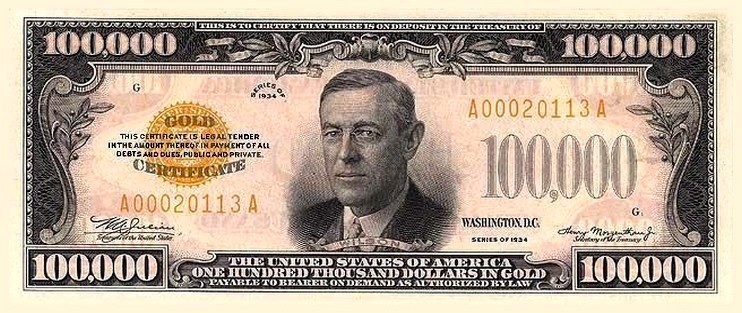Federal Reserve Act of 1913

On December 23, 1913, President Woodrow Wilson signed the Federal Reserve Act into law. The landmark legislation created the Federal Reserve, which was intended to reform the country’s banking system and help secure economic stability.
The Need for Banking Reform
In the early 20th Century, the United States was the only world power without a central bank. With a financial crisis looming in 1907, the country was forced to turn to the private sector, namely J.P. Morgan, to bail out the banking system and prevent a panic. As a more permanent solution, Congress passed the Aldrich-Vreeland Act on May 30, 1908. The law authorized the issuance of emergency currency and created National Monetary Commission. The 18-member committee, which was chaired by Sen. Nelson Aldrich, was tasked with determining how best to reform the country’s monetary system and related financial laws.
The National Monetary Commission conducted hearings, met with European leaders, and solicited input from the banking industry. It ultimately recommended the creation of a National Reserve Association. Under Aldrich’s plan, the Board would be comprised of 46 members, only six of which would be appointed by the government. The government would also have no stake in the National Reserve Association.
Progressives were highly critical of the banker-controlled plan, and the Commission’s proposal lost traction when Democrat Woodrow Wilson was elected President in 1912. Nonetheless, there was a still a consensus that banking and currency reform was needed.
In March of 1913, the newly created House Banking and Currency Committee appointed Rep. Carter Glass to head a subcommittee and come up with a new proposal. With the advice of H. Parker Willis, formerly a professor of economics at Washington and Lee University, Rep. Glass revised the existing Aldrich plan to include a system of regional banks rather than one large central body. While Rep. Glass also allocated the majority of the oversight to private bankers rather than the government, President Wilson insisted on the inclusion of a Federal Reserve Board comprised of presidential appointees.
In the Senate, Sen. Robert L. Owen drafted a competing bill. Among the notable difference between the two proposals, Owen’s plan reduced the number of Reserve Banks and changed the composition of the Board. In committee, a final proposal, known as the Glass-Owen bill, was drafted to reconcile the Senate and House versions.
The Creation of the Federal Reserve
The final version of the Federal Reserve Act called for a decentralized central bank and sought to balance the competing interests of private banks and government oversight. Its official title read:
An Act to provide for the establishment of Federal reserve tic currency, to afford means of rediscounting commercial paper, to establish a more effective supervision of banking in the United States, and for other purposes.
The Federal Reserve Act called for at least eight and no more than twelve private regional Federal Reserve banks. It also required nationally chartered banks to become members of the Federal Reserve and set aside minimum levels of reserves with one of the Federal Reserve banks.
The Federal Reserve Board was to consist of seven members, including the Secretary of the Treasury and the Comptroller of the Currency. The President was given the authority to appoint the members, which also had to be confirmed by the Senate. The Federal Reserve Act also mandated that members of the Board serve staggered terms of ten years to ensure no president could appoint all governors during consecutive terms.
Previous Articles
Key Takeaways from Oral Arguments in Court’s Controversial Voting-Rights Case
by DONALD SCARINCI on November 12, 2025
The U.S. Supreme Court recently heard oral arguments in Louisiana v. Callais, which involves a key ...
Key Cases to Watch During the Supreme Court’s November Sitting
by DONALD SCARINCI on November 5, 2025
The U.S. Supreme Court’s November sitting begins on November 3 and concludes on November 12, 2025...
SCOTUS Clears Way to Terminate Protected Status for Venezuelan Nationals
by DONALD SCARINCI on October 29, 2025
On October 3, 2025, the U.S. Supreme Court granted an emergency request from the Trump Administrati...
The Amendments
-
Amendment1
- Establishment ClauseFree Exercise Clause
- Freedom of Speech
- Freedoms of Press
- Freedom of Assembly, and Petitition
-
Amendment2
- The Right to Bear Arms
-
Amendment4
- Unreasonable Searches and Seizures
-
Amendment5
- Due Process
- Eminent Domain
- Rights of Criminal Defendants
Preamble to the Bill of Rights
Congress of the United States begun and held at the City of New-York, on Wednesday the fourth of March, one thousand seven hundred and eighty nine.
THE Conventions of a number of the States, having at the time of their adopting the Constitution, expressed a desire, in order to prevent misconstruction or abuse of its powers, that further declaratory and restrictive clauses should be added: And as extending the ground of public confidence in the Government, will best ensure the beneficent ends of its institution.





